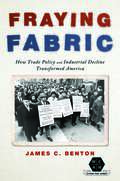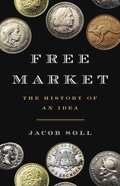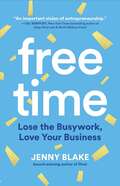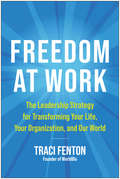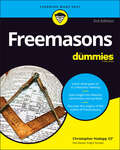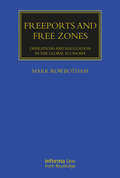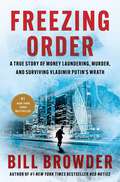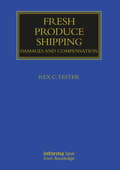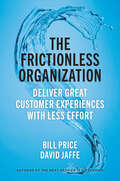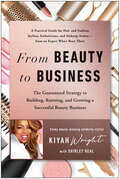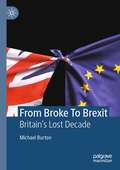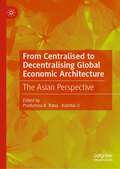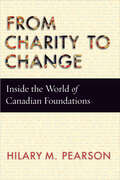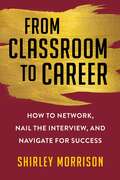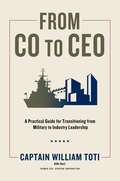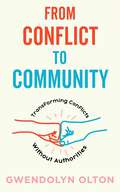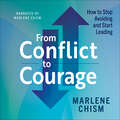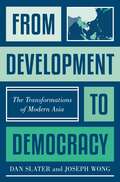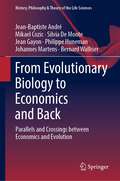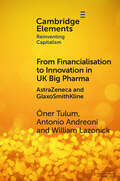- Table View
- List View
Frauen in Führungspositionen: Eine länderübergreifende Analyse der Barrieren und Erfolgsfaktoren
by Hanna ParnowNoch immer sind in Deutschland weniger Frauen in Führungspositionen als Männer, trotz vielfältiger Bemühungen seitens der Unternehmen, der Politik und den Frauen selbst. Werfen wir den Blick in unsere Nachbarländer, scheint es in Skandinavien oder Frankreich einfacher zu gelingen, Familie und Karriere unter einen Hut zu bringen und Führungspositionen attraktiv und gestaltbar für Frauen zu machen.Das Ziel des Buches ist es, einen qualitativen Überblick über die verschiedenen Barrieren und Erfolgsfaktoren für Frauen in Führungspositionen zu geben, die in Deutschland sowie anderen europäischen Ländern in wissenschaftlichen Studien der letzten Jahre belegt wurden. Denn das Potenzial der Frauen zu nutzen, wird einer der wichtigsten ökonomischen Einflussfaktoren der kommenden Jahre im digitalen und demografischen Wandel sein. Die Bereiche, die in Deutschland und anderen europäischen Ländern dabei relevant sind, sind aufgeteilt in Strukturen in Unternehmen und Gesellschaft, Geschlechterrollen und Work-Life-Balance.
FrauenStärken – Mit Working Out Loud die berufliche und gesellschaftliche Position von Frauen fördern
by Claudia SalowskiIm Januar 2021 starteten rund 3000 Teilnehmende mit der bisher größten konzertierten Initiative zur Stärkung und Unterstützung von Frauen in deutschen Organisationen: WOL #FrauenStärken. Mit der von John Stepper entwickelten Methode „Working Out Loud“ arbeiteten sie zwölf Wochen lang in rund 600 sogenannten „WOL Circles“.Dieses Buch reflektiert die Initiative in mehrfacher Hinsicht: Es schildert die Ausgangsposition 2020/21 bezüglich der Situation von Frauen in Organisationen in Deutschland, ihren Anteil an Positionen in der Führungsetage deutscher Unternehmen, und es stellt die Methode Working Out Loud (WOL) vor. Hier liegt besonderes Augenmerk auf der Wechselwirkung von Stärkungseffekten für die Einzelperson durch das Sichtbarmachen des eigenen Themas und dessen Fortschritts über die Zeit mit den Stärkungseffekten, die der Aufbau von Beziehungen speziell zur Unterstützung dieses Themas sowohl auf die Einzelperson als auch auf das aufgebaute Netzwerk hat. Das Werk stellt 15 Teilnehmende und ihre jeweiligen Ziele für WOL #FrauenStärken vor und betrachtet dabei an konkreten Beispielen drei verschiedene Arten von Zielen: solche, die auf die eigene Stärke von Frauen einzahlen; solche, die dazu beitragen, strukturelle Rahmenbedingungen zur Stärkung von Frauen in Organisationen zu schaffen oder zu fördern; und solche, die die gesamtgesellschaftliche Stärkung von Frauen in den Blick nehmen.Das Buch richtet sich an Frauen, die ihre eigene berufliche und gesellschaftliche Position stärken, an Personen jeden Geschlechts, die Frauen unterstützen und Rahmenbedingungen hierfür schaffen oder fördern wollen und an alle, die sich Ideen und Anregungen holen möchten, wo und wie das im Rahmen der Initiative WOL #FrauenStärken beispielhaft gelungen ist. Besonders Führungskräfte, Personalverantwortliche und Gleichstellungsbeauftragte erhalten Impulse zur Förderung von Frauen durch die Schaffung struktureller Voraussetzungen.
Fraying Fabric: How Trade Policy and Industrial Decline Transformed America (Working Class in American History)
by James C. BentonThe decline of the U.S. textile and apparel industries between the 1940s and 1970s helped lay the groundwork for the twenty-first century's potent economic populism in America. James C. Benton looks at how shortsighted trade and economic policy by labor, business, and government undermined an employment sector that once employed millions and supported countless communities. Starting in the 1930s, Benton examines how the New Deal combined promoting trade with weakening worker rights. He then moves to the ineffective attempts to aid textile and apparel workers even as imports surged, the 1974 pivot by policymakers and big business to institute lowered trade barriers, and the deindustrialization and economic devastation that followed. Throughout, Benton provides the often-overlooked views of workers, executives, and federal officials who instituted the United States’ policy framework in the 1930s and guided it through the ensuing decades. Compelling and comprehensive, Fraying Fabric explains what happened to textile and apparel manufacturing and how it played a role in today's politics of anger.
Free Market: The History of an Idea
by Jacob SollFrom a MacArthur &“Genius,&” an intellectual history of the free market, from ancient Rome to the twenty-first centuryAfter two government bailouts of the US economy in less than twenty years, free market ideology is due for serious reappraisal. In Free Market, Jacob Soll details how we got to this current crisis, and how we can find our way out by looking to earlier iterations of free market thought. Contrary to popular narratives, early market theorists believed that states had an important role in building and maintaining free markets. But in the eighteenth century, thinkers insisted on free markets without state intervention, leading to a tradition of ideological brittleness. That tradition only calcified in the centuries that followed.Tracing the intellectual evolution of the free market from Cicero to Milton Friedman, Soll argues that we need to go back to the origins of free market ideology in order to truly understand it—and to develop new economic concepts to face today&’s challenges.
Free Time: Lose The Busywork, Love Your Business
by Jenny BlakeTime is not money. Time is life force. Are you consistently doing the work that you and only you can do? Or are you burdened by busywork, the bottleneck blocking your company's profit and potential? Your time is far more precious than money. It is your presence, your memories, your quality of life. As a business owner, you are already paying a risk and pressure tax. For many, growth fueled by added stress is not worth the trade-off. You have an urge to simplify and streamline. Free Time is not about working as little as possible. Nor is it about creating a lifestyle business purely for one's own gain. It is about creating a life-giving business energizing every single person who is a part of it, from the owner to team members, to clients and community. Free Time is about making small investments now to create greater optionality in the future. A more joyful business is within reach. Imagine: Traveling, going off the grid, or handling family emergencies without panicking that everything will fall apart while you are gone. Working 10- to 20-hour weeks, delegating the rest to a part-time remote team. Answering questions with relief, knowing you don't have to "own" the next steps. Empowering your Delightfully Tiny Team™ to answer their own questions before they even have to ask you. Harnessing your creative energy for the strategic projects that excite you most. Jenny Blake, author of the award-winning book Pivot and co-creator of Google's acclaimed Career Guru coaching program, is back with her signature blend of heart-based operating principles and practical tools. This book will teach you how to move from friction to flow through smarter systems and the three-stage Free Time Framework.™ Free Time is a playbook to free your mind, time, and team for your best work. This book will teach you and your team to operate efficiently and intuitively while earning abundantly, so you can make your greatest contribution as a business owner.
Freedom at Work: The Leadership Strategy for Transforming Your Life, Your Organization, and Our W orld
by Traci FentonDiscover the leadership strategy for unlocking your team&’s greatness. Whether it shows up as stress, top-down leadership styles, drama, or uncertainty, fear kills good decision-making, dampens morale, lowers employee engagement, and hurts bottom-line growth. The good news is that there&’s an antidote: Freedom at Work.In this groundbreaking book, Traci Fenton brings together decades of original research, based on her team&’s work with hundreds of top companies around the world, such as The WD-40 Company, Mindvalley, DaVita, Menlo Innovations, Zappos, HCL Technologies, and more, revealing the proven pathway to leadership success. This powerful strategy will benefit any leader at any level in any type of organization, from entrepreneurs to mid-level managers to the C-suite. Freedom at Work is based on three key pillars: • Freedom-Centered Mindset: Break through limitations, make better decisions, and act with clarity and confidence • Freedom-Centered Leadership: Lead yourself and others from a place of freedom rather than fear • Freedom-Centered Design: Develop a world-class culture based on the 10 Principles of Organizational Democracy Freedom at Work is a revolutionary guide that will help make any organization high-performing and highly profitable, while creating a culture people love. This book will help passionate leaders weave freedom and democracy into our global tapestry through the way they run their teams and organizations—ultimately transforming our world for the better.
The Freedom Fund (A): Ending Modern Slavery
by V. Kasturi Rangan Courtney HanThe Freedom Fund founded in 2013 to end modern slavery had raised more than half its intended target (by 2025) of $200 million. In 2021, impressed by its decentralized-partnering style of operations, philanthropist MacKenzie Scott awarded the Fund a gift of $35 million over 5 years. The beauty of the gift was that it came with no strings attached. It was completely unrestricted for use the way the company's management and staff deemed fit. Nick Grono, the organization's first CEO was wrestling with the question of how to put the money to best use.
The Freedom Fund (B)
by V. Kasturi Rangan Courtney HanThe Freedom Fund (B) case describes the management's plan of how to use the windfall of $35 million granted by philanthropist Mackenzie Scott. The case also describes the process by which the decisions were arrived at.
Freemasons For Dummies
by Christopher HodappUnravel the mysteries of the Masons All the myths and rumors about Masonic organizations probably have you wondering "what do Masons really do?" Questions like this one are a natural by-product of being the oldest and largest "secret society" in the world. This book is an ideal starting place to find answers to your questions about the secret and not-so-secret things about Freemasonry. Now in its third edition, this international best-seller peeks behind the door of your local Masonic lodge and explains the meanings behind the rituals, rites, and symbols of the organization. Along the way the book covers nearly 3,000 years of Masonic history, introduces you to some famous Freemasons you already know from history books, and explains the relationship with related groups like Knights Templar, Scottish Rite, Order of Eastern Star, and the beloved fez-wearing Shriners. Look inside the book to learn: What it takes to become a member of the Freemasons, and what you can expect when you join How Lodges are organized and what really goes on during Masonic ceremonies The basic beliefs and philosophies of Freemasonry, including how Masons contribute to charity, and society in general The origins behind some of the wild myths and conspiracy theories surrounding Freemasonry and how to debunk (most of) them Written by a 33rd degree Scottish Rite Mason and the Public Relations and Marketing Director for the Grand Lodge F&AM of Indiana, Freemasons For Dummies is a must-read guide for anyone interested in this ancient fraternal order, whether you're looking to join or are just curious about some of the more mysterious aspects of Freemasonry.
Freeports and Free Zones: Operations and Regulation in the Global Economy (Maritime and Transport Law Library)
by Mark RowbothamThis book explains the definition, concepts, practices and procedures of Free Zone operations; how they are created, how they operate, and their benefits to the global and national economy. Readers will be able to understand why Free Zones exist, their role in the development and maintenance of international trade, and how they contribute to national and global economic development and wellbeing, especially in developing nations. The author explains the processes in the establishment of Free Zones, and how government legislation and initiatives assist in this process. The book comprehensively but accessibly covers the topics of Freeports, Free Zones, Export Processing Zones (EPZs) and Special Economoic Zones (SEZs), as well as issues such as Customs requirements, Free Zone law and government initiatives, including the new UK Freeport initiative. It analyses the role of such Zones in global economic development and considers the challenges and issues related to Free Zone development and operation, including security and potential crime. The book also provides a series of case studies into selected global examples of Free Zones, EPZs and SEZs. Freeports and Free Zones will have a broad readership, being of interest to global economic, fiscal and government institutions, policymakers, legal practitioners and advisers, economic and business advisers, port and airport authorities and major multinational enterprises. It will be especially relevant to the food, automotive, defence, manufacturing, logistics, Fast Moving Consumer Goods (FMCG), pharmaceutical, aviation and maritime industries.
Freezing Order: A True Story of Money Laundering, Murder, and Surviving Vladimir Putin's Wrath
by Bill BrowderFollowing his explosive New York Times bestseller Red Notice, Bill Browder returns with another gripping thriller chronicling how he became Vladimir Putin’s number one enemy by exposing Putin’s campaign to steal and launder hundreds of billions of dollars and kill anyone who stands in his way. <p><p>When Bill Browder’s young Russian lawyer, Sergei Magnitsky, was beaten to death in a Moscow jail, Browder made it his life’s mission to go after his killers and make sure they faced justice. The first step of that mission was to uncover who was behind the $230 million tax refund scheme that Magnitsky was killed over. <p><p>As Browder and his team tracked the money as it flowed out of Russia through the Baltics and Cyprus and on to Western Europe and the Americas, they were shocked to discover that Vladimir Putin himself was a beneficiary of the crime. <p><p>As law enforcement agencies began freezing the money, Putin retaliated. He and his cronies set up honey traps, hired process servers to chase Browder through cities, murdered more of his Russian allies, and enlisted some of the top lawyers and politicians in America to bring him down. Putin will stop at nothing to protect his money. <p><p>As Freezing Order reveals, it was Browder’s campaign to expose Putin’s corruption that prompted Russia’s intervention in the 2016 US presidential election. At once a financial caper, an international adventure, and a passionate plea for justice, Freezing Order is a stirring morality tale about how one man can take on one of the most ruthless villains in the world—and win. <p> <b>New York Times Bestseller</b>
Fresh Produce Shipping: Damages and Compensation (Maritime and Transport Law Library)
by Rex C. TesterThis book is an in-depth study of air and ocean goods-in-transit claims. It sets out to guide and assist businesses within the fresh produce industry to successfully implement the best processes and procedures to maximise their recovery efforts against contracted carriers. Fresh Produce Shipping focuses heavily on protecting the rights and recovery aspects of companies involved in growing, selling, and transporting fresh produce. It gives importers, exporters, loss adjusters, surveyors, and freight forwarders an easy-to-understand guide to the management and requirements of submitting claims. It provides an overview of the shipping terms and procedures involved when raising a claim. The book offers specific and detailed industry knowledge to stakeholders who would not normally have access to such information without the employment of specialists or legal counsel, providing an inexperienced reader with the tools to submit a claim and achieve an understanding of protocol. A valuable guide and comprehensive reference for parties seeking compensation for lost or damaged goods, this book will be of relevance to shippers and importers of fresh produce, lawyers acting for commercial clients and underwriters, cargo surveyors, trade bodies around the world representing fresh produce operators, and forwarders wishing to support their clients.
Freshwaters and Wetlands of Patagonia: Ecosystems and Socioecological Aspects (Natural and Social Sciences of Patagonia)
by Gabriela Mataloni Rubén D. QuintanaThe Freshwaters of Patagonia adopts a socioecological approach, in which experts from across Patagonia review recent, scientifically rigorous literature and data of their own, thus synthesizing the current knowledge directly relevant to understand the present state and future trends of icefields, freshwater and wetland ecosystems in this region.The book’s organization into three parts provides a studied and comprehensive view on the patterns and processes of the various ecosystems in Patagonia, and describes the sociological aspects of freshwater ecosystems, as well as characterizes the conservation of the freshwater and wetland ecosystems, in Patagonia. The chapters offer a broad, state-of-the-art overview of the current status of glaciers, freshwater and wetland ecosystems of this region, as well as studies of both local and large scale biodiversity patterns, and study cases of extreme and naturally polluted environments.The volume concludes with the current status of Patagonian freshwaters, and discusses the scientific, legal and administrative tools aimed at their sustainable management within the framework of the UNEP Sustainable Development Goals 2030 Agenda. A broad audience of students, scientists, engineers, environmental managers, and policy makers will be interested in this volume.
The Frictionless Organization: Deliver Great Customer Experiences with Less Effort
by Bill Price David JaffeLearn how frictionless organizations cut costs, grow revenue, and create loyal fans by creating products and services that work so well, their customers never have to contact them for the wrong reasons.This book will help any customer-facing organization deliver better customer experiences, save money, and increase revenue. Veteran customer service experts Bill Price and David Jaffe, coauthors of the bestseller The Best Service Is No Service, explain how organizations can design products, sales, and support so that customer effort is reduced or, better still, removed. This simplicity for the customer is what Price and Jaffe call frictionless. The book defines a straightforward methodology, drawing on more than thirty practical examples from leading companies across four continents. The approach provides a radically different way for the whole business to focus on the customer experience. It explains how any organization can look at all customer interactions as potential opportunities for improvement and question whether they are helpful or represent symptoms of friction. Lower friction innovators are disrupting established businesses in every industry. This detailed guide shows how any business—from start-ups to major multinational corporations—can remove friction. Being frictionless has become a strategic necessity, and now this strategy is available to any organization.
From Beauty to Business: The Guaranteed Strategy to Building, Running, and Growing a Successful Beauty Business
by Kiyah WrightYou know you have the talent to make it in the beauty industry, but figuring out where to begin can feel like a mystery—and cosmetology schools often don&’t prepare students for the business end of these jobs . . . which can make or break your career.Consider this book your crash course on how current and aspiring beauty professionals can profit from their passions to create wealth beyond their wildest dreams.Entrepreneur and celebrity hairstylist Kiyah Wright knows exactly what it takes to amass wealth in the hair and beauty industry. From the time she was just 14 years old and doing hair in her grandmother's basement for $20 a pop, Kiyah had found her calling. By 17, she had 200 clients and netted over $60K a year. Now, 25 years later, she's at the top of her game with A-List Hollywood clientele, two Emmy Awards, two Hollywood Beauty Awards, a thriving business, and a million-dollar brand. In From Beauty to Business, Wright breaks down her seven proven success principles that helped her achieve her goals: • Developing a success mindset • Understanding the business of the beauty business • Finding your niche • Diversifying with multiple streams of income • Growing your platform to grow your profits • Preparing for the unexpected • Planning for your future She also lays out crucial success strategies not taught in hair or beauty schools about entrepreneurship, finance, branding, marketing, product distribution, how to harness the power of social media, and how to build wealth. Whether you&’re working from your house or a salon, From Beauty to Business will set you up for success with practical tools for thriving in the beauty business on your own terms. This first-of-its-kind sourcebook features Kiyah&’s favorite success affirmations, industry-themed business templates, worksheets, and the foolproof strategies Kiyah used to attract and retain superstar clients like Tyra Banks, Jennifer Hudson, Ciara, Iman, Taraji P. Henson, and Gabrielle Union. Whether you&’re looking for tips in your career as a hairstylist, makeup artist, esthetician, or other beauty professional, From Beauty to Business is the ultimate resource guide that will set you on a straight path to success.
From Broke To Brexit: Britain’s Lost Decade
by Michael BurtonPerhaps the most extraordinary period in modern British history, the years between the Great Recession and Brexit have often been dubbed ‘the lost decade’ because of the economic and political turmoil caused by those two great events. Michael Burton outlines how the first led to the second, assisted by a rare confluence of other, often unrelated, social and political factors that delivered the shock Leave verdict in the EU referendum of 2016. These included the longstanding grievances of voters in former industrial areas feeling left behind by globalism, stagnant incomes after the recession, austerity, the rise of social media, the refugee and Eurozone crisis in Europe, the deep split in the Conservative and Labour parties over the EU and rising wealth inequalities. The author also charts the chaotic political landscape that ended in the final Brexit deal. This book is ideal for the general reader as well as for students of politics, history and economics needing a concise and well-explained account of this turbulent period in British history.
From Centralised to Decentralising Global Economic Architecture: The Asian Perspective
by Pradumna B. Rana Xianbai JiThis book focuses on the recent rise of new regional economic institutions such as the Chiang Mai Initiative Multilateralisation, the Asian Infrastructure Investment Bank, and the Regional Comprehensive Economic Partnership, which were established, in part, as a result of dissatisfaction of dynamic emerging markets with global economic institutions such as the IMF, the World Bank, and the GATT/WTO. The latter were formed by advanced economies in the West, after the historic Bretton Wood Conference of 1944. In doing so, the book addresses how this recent round of decentralisation, defined as the co-existence of “senior” global institutions and a plethora of newly-established regional institutions, has affected global economic governance, and the delivery of global public goods. It also poses the question if this has led to the fragmentation of global economic governance. The book adds value to existing literature by using a benefit-risk analytical framework to study the decentralisation process. Unlike the “contested multilateralism” argument used by some authors which focuses on the costs of decentralisation, the authors argue that benefits must also be considered. It also describes and analyses the establishment of global and regional international economic institutions and the evolving relationships between the two. Third, the authors argue that this decentralisation process will continue in the postpandemic period and recommend policies to reset the relationship between global and regional institutions. And lastly, the book discusses proposals to reform the international monetary system including the global reserve system with a view to reducing the hegemony of the US dollar.Throughout the book, the role for Asia is also identified, and elaborated on.
From Charity to Change: Inside the World of Canadian Foundations
by Hilary M. PearsonThe world of philanthropy and private foundations remains mysterious to most Canadians. Memorably likened to giraffes, foundations are creatures that should not exist, but they do, surrounded by a certain mystique.In From Charity to Change Hilary Pearson demystifies the world of Canadian philanthropy, offering a portrait of today’s foundation landscape and highlighting organizations that are acting with purpose on some of the most pressing social and economic challenges of our time: climate change, the future of cities, education and the evolving workforce, housing, and the urgent need to repair and build new relationships with Indigenous Peoples. Pearson, who for two decades worked with leaders of foundations across Canada, provides an insider’s perspective on the ways these organizations continue to evolve. Through personal interviews with private funders – large and small, long established and newly formed – Pearson describes their strategies and the varied roles they play, whether as convenors, advocates, brokers, or partners.A timely contribution to the current debate on the legitimacy of organized philanthropy in an era of increasing social division and inequality, From Charity to Change makes a compelling case for the valuable role private philanthropy plays in addressing the challenges of our rapidly changing times.
From Classroom to Career: How to Network, Nail the Interview, and Navigate for Success
by Shirley MorrisonAn authentic, engaging, and practical guide to help college grads thrive personally and professionally.The rules have changed; the traditional workplace is dead. To BOOM in employment today, the secret is to alter the approach, and From Classroom to Career will tell you how. Gen Z and Millennials are asking for this value-led guide as they embark on careers.Entertaining, personal, and relatable, the voice of the book is purposely casual, as if speaking in a café. It&’s a voice everyone trusts. Reasonable, logical, and concrete advice for today&’s how-to: how to write a business email; how to successfully land and then stand out in an interview, including in a virtual world; how to ask questions that can be adapted to any job/role; how to write a CV with examples. Inspiring, surprising, real-life stories show empathy for what the readers are likely going through, so they&’ll forget it&’s a business book.From Classroom to Career integrates the personal and career. This is in fact the real reality of every human being: we&’re so much more than careerists. It&’s impossible to thrive career-wise if you are not happy outside of work. People are happier when they have a balance, enabling them to achieve personally and professionally. By helping readers to discover their own values, this guide gets them to think about their own career and who they want to be. This is entirely unlike any other business book out there.
From CO to CEO: A Practical Guide for Transitioning from Military to Industry Leadership
by Captain William J. TotiIn From CO to CEO: A Practical Guide for Transitioning from Military to Industry Leadership, William J. Toti, former CO of the nuclear submarine USS Indianapolis and former CEO of Sparton Corporation, offers a seminal manual for service members transitioning to civilian careers and navigating their rise up the corporate ladder. You&’ve served your country dutifully, and as a member of the US armed forces you&’ve also developed a discipline, drive, and skillset admired the world over. Your success in the civilian job market after your military career ends is all but ensured, right? Well, if statistics and real-life reports from your predecessors are any indication, this transition is not always smooth sailing. More than 200,000 service members separate from the military each year. More than half of those surveyed about the process felt as if they had little to no help with the transition. That&’s why William J. Toti, retired naval officer and CEO of Sparton Corporation, wrote From CO to CEO: A Practical Guide for Transitioning from Military to Industry Leadership. As someone who successfully progressed from captain of a nuclear submarine to a captain of industry, he knows what it takes to make the most of your military training and what more is needed to rise up the ranks in the C-suite. From CO to CEO aims to help you get the most out of your industry career, thinking through the kind of company and career track that is best for you. It provides a step-by-step guide to navigating the search, interview, and negotiation process and helps you acclimate to your new environment and to accelerate your climb to the top.
From Conflict to Community: Transforming Conflicts Without Authorities
by Gwendolyn OltonConflict is everywhere: our living rooms, our streets, our community organizations, and every corner of the internet. But few of us have the training to successfully intervene or resolve these conflicts. In these pages, experienced peacemaker Gwendolyn Olton shows you how to use your existing skills and intuition to transform a wide variety of conflicts from insurmountable impasses to working relationships where everyone's needs are met. The result is a practical, kind, realistic guidebook for anyone who's found themselves in a conflict (their own or someone else's) and wondered, "How did we get here and what can I do to make it better!?"The book is broken up into three sections: learn the basics of conflicts, help others work out their conflicts, and finally, resolve and heal the conflicts in your own life. Filled with real life examples and thought-provoking scenarios, Olton offers a variety of conflict analysis and conversation tools that you can use to navigate the most challenging interpersonal dynamics, and to better understand yourself and others along the way—all without calling HR or the cops.
From Conflict to Courage: How to Stop Avoiding and Start Leading
by Marlene ChismUnresolved conflict is workplace kryptonite. Learn how to develop the mindset and skills to defuse disagreements, overcome division, and turn conflict into an opportunity for growth.Unresolved workplace conflict wastes time, increases stress, and negatively affects business outcomes. But conflict isn't the problem, mismanagement is. Leaders unintentionally mismanage conflict when they fall into patterns of what Marlene Chism calls &“the Three As:&” aggression, avoidance, and appeasing. &“These coping mechanisms are ways human beings avoid the emotions that come with conflict, but in the end it's all avoidance,&” says Chism. In this book she shows how to fearlessly deal with conflict head-on by expanding your conflict capacity.Conflict capacity is a combination of three elements. The foundation is the Inner Game—the leader's self-awareness, values, discernment, and emotional integrity. The Outer Game is the skills, tools, and communication techniques built on that foundation. Finally, there's Culture—the visible and invisible structures around you that can encourage or discourage conflict. Chism offers exercises, examples, and expert guidance on developing all three elements. Leaders will discover techniques to increase leadership clarity, identify obstacles, and reduce resistance. They'll develop powerful skills for dealing with high-conflict people and for initiating, engaging in, and staying with difficult conversations. Readers will learn that when they see conflict as a teacher, courageously face it, and continually work on transforming themselves, they can get the resolution they are seeking. They can change minds.
From Development to Democracy: The Transformations of Modern Asia
by Dan Slater Joseph WongWhy some of Asia’s authoritarian regimes have democratized as they have grown richer—and why others haven’tOver the past century, Asia has been transformed by rapid economic growth, industrialization, and urbanization—a spectacular record of development that has turned one of the world’s poorest regions into one of its richest. Yet Asia’s record of democratization has been much more uneven, despite the global correlation between development and democracy. Why have some Asian countries become more democratic as they have grown richer, while others—most notably China—haven’t? In From Development to Democracy, Dan Slater and Joseph Wong offer a sweeping and original answer to this crucial question.Slater and Wong demonstrate that Asia defies the conventional expectation that authoritarian regimes concede democratization only as a last resort, during times of weakness. Instead, Asian dictators have pursued democratic reforms as a proactive strategy to revitalize their power from a position of strength. Of central importance is whether authoritarians are confident of victory and stability. In Japan, South Korea, and Taiwan these factors fostered democracy through strength, while democratic experiments in Indonesia, Thailand, and Myanmar were less successful and more reversible. At the same time, resistance to democratic reforms has proven intractable in Singapore, Malaysia, Hong Kong, China, Vietnam, and Cambodia. Reconsidering China’s 1989 crackdown, Slater and Wong argue that it was the action of a regime too weak to concede, not too strong to fail, and they explain why China can allow democracy without inviting instability.The result is a comprehensive regional history that offers important new insights about when and how democratic transitions happen—and what the future of Asia might be.
From Evolutionary Biology to Economics and Back: Parallels and Crossings between Economics and Evolution (History, Philosophy and Theory of the Life Sciences #28)
by Philippe Huneman Jean Gayon Bernard Walliser Mikael Cozic Jean-Baptiste André Silvia De Monte Johannes MartensThis book offers a comprehensive exploration of the major key concepts common to economics and evolutionary biology. Written by a group of philosophers of science, biologists and economists, it proposes analyses of the meaning of twenty-five concepts from the viewpoint respectively of economics and of evolutionary biology –each followed by a short synthesis emphasizing major discrepancies and commonalities. This analysis is surrounded by chapters exploring the nature of the analogy that connects evolution and economics, and chapters that summarize the major teachings of the analyses of the keywords. Most scholars in biology and in economics know that their science has something in common with the other one, for instance the notions of competition and resources. Textbooks regularly acknowledge that the two fields share some history – Darwin borrowing from Malthus the insistence on scarcity of resources, and then behavioral ecologists adapting and transforming game theory into evolutionary game theory in the 1980s, while Friedman famously alluded to a Darwinian process yielding the extant firms. However, the real extent of the similarities, the reasons why they are so close, and the limits and even the nature of the analogy connecting economics and biological evolution, remain inexplicit. This book proposes basis analyses that can sustain such explication. It is intended for researchers, grad students and master students in evolutionary and in economics, as well as in philosophy of science.
From Financialisation to Innovation in UK Big Pharma: AstraZeneca and GlaxoSmithKline (Elements in Reinventing Capitalism)
by Öner Tulum Antonio Andreoni William LazonickThe tension between innovation and financialisation is central to the business corporation. Innovation entails a 'retain-and-reinvest' allocation regime that can form a foundation for stable and equitable economic growth. Driven by shareholder-value ideology, financialisation entails a shift to 'downsize-and-distribute'. This Element investigates this tension in global pharmaceuticals, focusing on the two leading UK companies AstraZeneca and GlaxoSmithKline. In the 2000s both adopted US-style governance, including stock buybacks and stock-based executive pay. Over the past decade, however, first AstraZeneca and then GlaxoSmithKline transitioned to innovation. Critical was the cessation of buybacks to refocus capabilities on investing in an innovative drugs pipeline. Enabling this shift were UK corporate-governance institutions that mitigated US-style shareholder-value maximisation. Reinventing capitalism for the sake of stable and equitable economic growth means eliminating value destruction caused by financialisation and supporting value creation through collective and cumulative innovation. This title is also available as Open Access on Cambridge Core.


